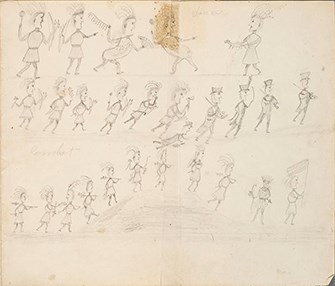Last updated: September 13, 2022
Article
Native nations face the loss of land and traditions
The impacts the War of 1812 had on tribes were simply devastating. Afterwards, the United States was firmly established as the preeminent power in North America, growing in size and power each passing year. With a military force at its disposal and an expanding need for land, tribal nations knew: accept the terms given by the United States, or face annihilation.
Unable to perform ceremonies and traditions in native tongues, a slow loss of tradition and identity became inevitable.

Weltmuseum, Vienna
A mere 15 years after the War of 1812 concluded, President Andrew Jackson introduced the Indian Removal Act of 1830. When the law passed, it gave the United States the green light to formally and legally remove tribal communities under “western law.” Before this, no such sweeping law sanctioned by the federal government existed, with compromise and treaties the only available solutions. Losing Indian lands resulted in a loss of cultural identity, as tribes relied on their homelands as the place of ancestral burial locations and sacred sites where religious ceremonies were performed. Without their lands, nations lost their identities, and their purpose.
This loss of identity corresponded with the rise of American hegemony, felt in every facet of tribal communities following the War of 1812. Native languages slowly gave way to English. Mandatory American boarding schools forbade native languages to be spoken. Children, alienated from their families, began to lose their languages and their cultures during their stay at these institutions. Unable to perform ceremonies and traditions in native tongues, a slow loss of tradition and identity became inevitable.
In the Odawa community at Little Traverse, the famed missionary Frederic Baraga carried out his work preaching and baptizing community members, and building Catholic churches from 1831 to 1833. Immediately upon his arrival, Baraga built a large fire in the center of Little Traverse. He demanded that those who were serious about converting to the Catholic faith burn their sacred bundles. Some Odawa did, other protested against changing their faith system. But this erosion of religious freedoms was common: it wasn’t until 1978, under the American Indian Religious Freedom Act, that tribal people could freely practice their traditional beliefs.
To avoid removal, “uncivilized” tribal communities showed “progress” by becoming Christian: changing their appearance, attending western schools, and abandoning traditional hunting practices in favor of farming. Odawa men were pressured to cut their hair and discontinue the practice of tattooing, while social pressures influenced Odawa women to wear American clothes and not traditional dress.
Before the War of 1812, tribes had the freedom to dress as they chose, speak their language, practice their religion, and access sacred sites and cultural resources related to the geographic landscapes of their ancestors. After the War of 1812, the changes were swift and drastic. But the love of home prompted many tribes to change only their outward identity to conform with American pressures for assimilation, while in secret continuing traditional beliefs and practices. A testament to this tenacity to tradition, despite pressures to abandon it, is seen in the contemporary community’s retention of traditional values and beliefs. Ancestors’ willingness to risk their lives and their freedom to practice traditional beliefs allows contemporary communities to hold on to and celebrate those practices.
